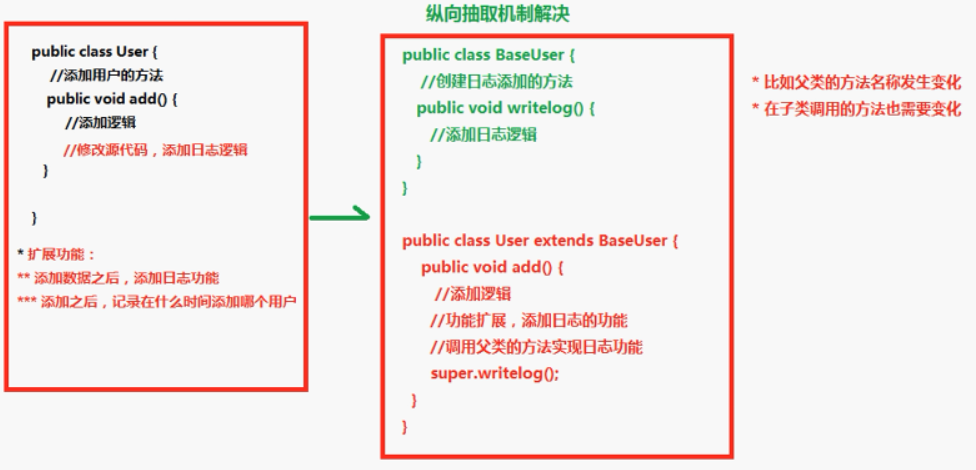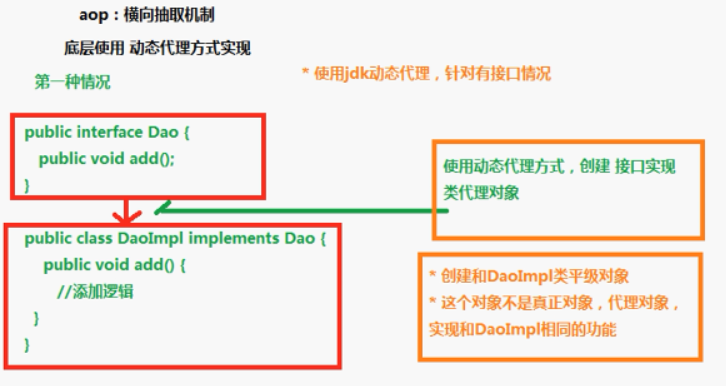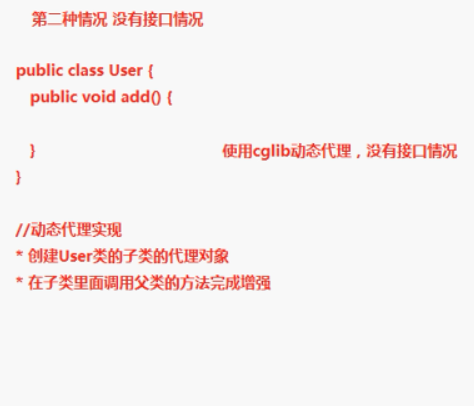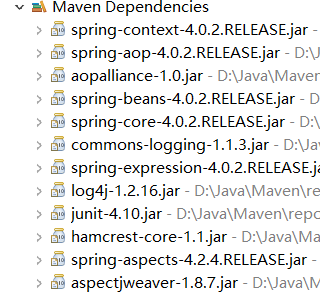详解AOP——用配置文件的方式实现AOP
AOP概念
1、AOP:面向切面(方面)编程,扩展功能不修改源代码实现
AOP原理
AOP采用横向抽取机制,取代了传统纵向继承体系重复性代码
传统的纵向抽取机制:

横向抽取机制:


AOP操作术语
1、Joinpoint(连接点):所谓连接点是指那些被拦截到的点。在Spring中这些点指的是方法,因为Spring只支持方法类型的连接点。
——即类里面可以被增强的方法,这些方法被称为连接点。
2、Pointcut(切入点):所谓切入点是指我们要对那些 Joinpoint 进行拦截的定义
——在类中,实际被增强的方法就是切入点。(即连接点不一定是切入点,而切入点一定是连接点)
3、Advice(通知 / 增强):所谓通知是指拦截到 Joinpoint 之后所要做的事情就是通知,通知分为前置通知、后置通知、异常通知、最终通知、环绕通知(切面要完成的功能)
-
- 前置通知:在方法之前执行
- 后置通知:在方法之后执行
- 异常通知:方法出现异常执行
- 最终通知:在后置通知之后执行
- 环绕通知:在方法之前和之后执行
4、Aspect(切面):是切入点和通知(或引介)的结合
——把增强应用到具体方法(切入点)的过程称为切面。
5、Target(目标对象):代理的目标对象(要增强的方法所在的类)
6、Weaving(织入):是把增强应用到目标的过程,把 advice 应用到 target 的过程
7、Proxy(代理):一个类被AOP织入增强后,就产生一个结果代理类
8、Introduction(引介):引介是一种特殊的通知,在不修改类代码的前提下,Introduction 可以在运行期为类动态地添加一些方法或 Field
Spring中的AOP操作原理
1、在Spring里面进行AOP操作,使用 AspectJ 实现
(1)AspectJ 不是 Spring 一部分,和 Spring 一起使用进行 AOP 操作
(2)Spring2.0以后就新增了对 AspectJ 切点表达式的支持
(3)@AspectJ 是 AspectJ1.5 新增功能,通过 JDK5 注解技术,允许直接在Bean类中定义切面
(4)新版本的 Spring 框架,建议使用 AspectJ 来开发 AOP
2、使用 AspectJ 实现 AOP 有两种方式
(1)基于 AspectJ 的xml配置
(2)基于 AspectJ 的注解方式
Spring中AOP操作的准备工作
1、引入Jar包(Maven项目)
<dependencies>
<!-- 引入一个spring-context
会自动依赖 spring-core、spring-beans、spring-expression 三个核心包
以及spring-aop、aopalliance 两个aop相关jar包
和commons-logging 一个日志相关jar包
我们引入一个spring-context 会自动引入6个依赖jar (context是真核心!!)
-->
<dependency>
<groupId>org.springframework</groupId>
<artifactId>spring-context</artifactId>
<version>4.0.2.RELEASE</version>
</dependency>
<!-- 引入spring-aspects的jar包
会自动引入依赖的 aspectjweaver 的jar包
-->
<dependency>
<groupId>org.springframework</groupId>
<artifactId>spring-aspects</artifactId>
<version>4.2.4.RELEASE</version>
</dependency>
<dependency>
<groupId>log4j</groupId>
<artifactId>log4j</artifactId>
<version>1.2.16</version>
</dependency>
<dependency>
<groupId>junit</groupId>
<artifactId>junit</artifactId>
<version>4.10</version>
<scope>provided</scope>
</dependency>
</dependencies>
MavenDependencies

2、创建Spring核心配置文件,导入 AOP 的约束

使用表达式配置切入点
1、切入点:实际增强的方法
2、常用的表达式
execution(<访问修饰符>?<返回值类型><方法名>(参数)<异常>)
(1)execution(* com.bjxb.aop.Book.add(..))——星号代表匹配所有的访问修饰符(注意第一个星号后需要加空格),add(..)中的点代表可以有参数
(2)execution(* com.bjxb.aop.Book.*(..))——第二个星号代表Book类中所有的方法
(4)execution(* com.bjxb.aop. . *(..))——第二个星号前面的两个点代表该包、及其子包下所有的类,一个点不包含其子包
(5)execution(* *.*(..))——第二个星号代表所有的类
(6)execution(* save*(..))——匹配所有的save开头的方法
AspectJ 的 AOP操作
1、被增强类(目标对象和切入点)
public class Book {
public void add() {
System.out.println("add..........");
}
}
2、增强类(通知 / 增强)
public class MyBook {
public void before1() {
System.out.println("前置增强........");
}
public void after1() {
System.out.println("后置增强.......");
}
// 环绕通知
public void around1(ProceedingJoinPoint proceedingJoinPoint) throws Throwable {
// 方法之前
System.out.println("方法之前.........");
// 执行被增强的方法
proceedingJoinPoint.proceed();
// 方法之后
System.out.println("方法之后.........");
}
}
3、配置文件applicationContext.xml
<!-- 1.配置对象 -->
<bean id="book" class="com.bjxb.aop.Book"></bean>
<bean id="myBook" class="com.bjxb.aop.MyBook"></bean>
<!-- 2.配置AOP操作 -->
<aop:config>
<!-- 2.1配置切入点 -->
<aop:pointcut expression="execution(* com.bjxb.aop.Book.*(..))" id="pointcut1"/>
<!-- 2.2配置切面
把增强用到方法上面
-->
<aop:aspect ref="myBook">
<!-- 配置增强类型
method:增强类中使用哪个方法作为前置
-->
<aop:before method="before1" pointcut-ref="pointcut1"/>
<aop:after method="after1" pointcut-ref="pointcut1"/>
<aop:around method="around1" pointcut-ref="pointcut1"/>
</aop:aspect>
</aop:config>



